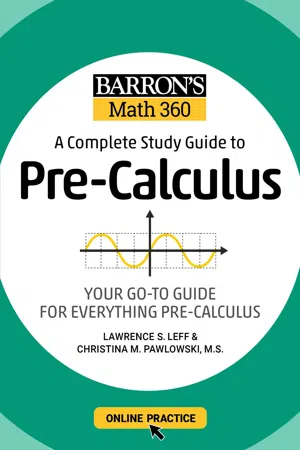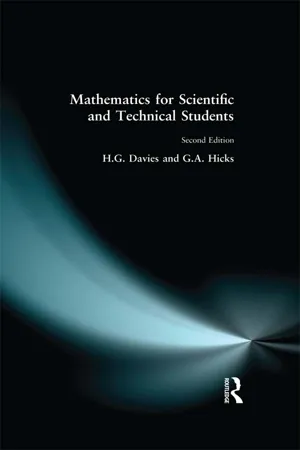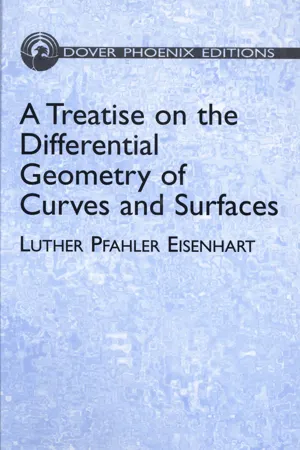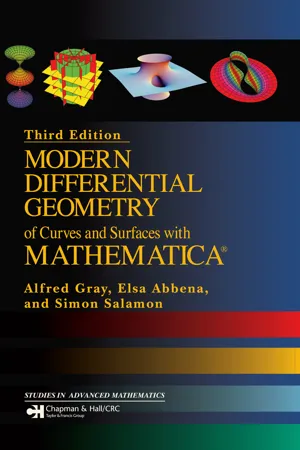Mathematics
Polar Curves
Polar curves are mathematical representations of equations in polar coordinates, where the distance from the origin and the angle determine the position of points on a plane. These curves are often used to describe complex shapes and patterns that are difficult to represent using Cartesian coordinates. They are particularly useful in fields such as physics, engineering, and astronomy.
Written by Perlego with AI-assistance
Related key terms
Related key terms
1 of 4
Related key terms
1 of 3
6 Key excerpts on "Polar Curves"
- Lawrence S. Leff, Christina Pawlowski-Polanish(Authors)
- 2021(Publication Date)
- Barrons Educational Services(Publisher)
STUDY UNIT IVPOLAR COORDINATES AND CONIC SECTIONSPassage contains an image
13 POLAR COORDINATES AND PARAMETRIC EQUATIONSWHAT YOU WILL LEARN
Up to now, a curve has been defined by a single equation in two variables and then graphed using rectangular coordinates. In certain situations, however, a curve may not provide a complete picture of the real-world situation it is modeling. For example, when the vertical position of a moving object is plotted against the horizontal position of the object, we can tell the position of the object from the graph, but not the time at which the object was at that position. In such situations, it is helpful to define a curve using two equations by writing x as a function of a third variable, say t, and also writing y as a function of t. The equations x = f(t) and y = g(t) define a curve parametrically in the coordinate plane.The polar coordinate system locates a point P in the plane using the ordered pair (r,θ), where the initial side of ∠θ is on the positive x-axis and its vertex, O, is fixed at the origin. The terminal side of ∠θ is the line segment OP, where r = OP, as shown in the accompanying figure.Connections between polar coordinates and graphs of complex numbers lead to relationships that allow us to find the nth roots of a complex number.LESSONS IN CHAPTER 13•Lesson 13-1: Parametric Equations•Lesson 13-2: The Polar Coordinate System•Lesson 13-3: The Polar Form of a Complex Number•Lesson 13-4: Powers and Roots of Complex NumbersLesson 13-1: Parametric Equations
KEY IDEAS
A plane curve can be described by a function that uses three variables instead of two. The extra variable, typically represented by t or θ, is called the parameter and provides additional information about the process or function represented by the curve.DEFINING A CURVE PARAMETRICALLY
Suppose that a particle is moving within the coordinate plane in such a way as to trace out the graph of y = x2 − 2x. From this function we know that at, say, x = 5, y = 15. However, we do not know from this function when the particle was at (5,15). Although the function allows us to determine the points where the particle has been, it does not tell us when- eBook - ePub
- Auguste Comte(Author)
- 2012(Publication Date)
- Perlego(Publisher)
The preceding discussion clearly shows that, although the ordinary system of rectilinear co-ordinates has no constant superiority over all others in one of the two fundamental points of view which are continually combined in analytical geometry, yet as, on the other hand, it is not constantly inferior, its necessary and absolute greater aptitude for the representation of equations must cause it to generally receive the preference; although it may evidently happen, in some particular cases, that the necessity of simplifying equations and of obtaining them more easily may determine geometers to adopt a less perfect system. The rectilinear system is, therefore, the one by means of which are ordinarily constructed the most essential theories of general geometry, intended to express analytically the most important geometrical phenomena. When it is thought necessary to choose some other, the polar system is almost always the one which is fixed upon, this system being of a nature sufficiently opposite to that of the rectilinear system to cause the equations, which are too complicated with respect to the latter, to become, in general, sufficiently simple with respect to the other. Polar co-ordinates, moreover, have often the advantage of admitting of a more direct and natural concrete signification; as is the case in mechanics, for the geometrical questions to which the theory of circular movement gives rise, and in almost all the cases of celestial geometry.In order to simplify the exposition, we have thus far considered the fundamental conception of analytical geometry only with respect to plane curves, the general study of which was the only object of the great philosophical renovation produced by Descartes. To complete this important explanation, we have now to show summarily how this elementary idea was extended by Clairaut, about a century afterwards, to the general study of surfaces and curves of double curvature. The considerations which have been already given will permit me to limit myself on this subject to the rapid examination of what is strictly peculiar to this new case.Passage contains an image
SURFACES.
Determination of a Point in Space. The complete analytical determination of a point in space evidently requires the values of three co-ordinates to be assigned; as, for example, in the system which is generally adopted, and which corresponds to the rectilinear system of plane geometry, distances from the point to three fixed planes, usually perpendicular to one another; which presents the point as the intersection of three planes whose direction is invariable. We might also employ the distances from the movable point to three fixed points, which would determine it by the intersection of three spheres with a common centre. In like manner, the position of a point would be defined by giving its distance from a fixed point, and the direction of that distance, by means of the two angles which this right line makes with two invariable axes; this is the polar - eBook - ePub
- Thomas F. Banchoff, Stephen T. Lovett(Authors)
- 2016(Publication Date)
- Chapman and Hall/CRC(Publisher)
On the website http://www.mathcurve.com/ entitled an Online Encyclopedia of Curves, the host credits this curve to Raphaël Laporte who designed this curve for his “petite amie” (translated “girl friend”). Example 1.1.15 (Polar Functions). Functions in polar coordinates are usually given in terms of the radius r as a function of the angle θ by r = f (θ). The graphs of such functions can be written as parametrized curves. Recall the coordinate transformation { x = r cos θ, y = r sin θ. Then take θ as the parameter t, and the parametric equations for the graph of r = f (θ) are X → (t) = (f (t) cos t, f (t) sin t). As an example, the polar function r = sin 3 θ traces out a curve that resembles a three-leaf flower. (See Figure 1.4.) As a parametric curve, it is given by X → (t) = (sin 3 t cos t, sin 3 t sin t). Figure 1.4. Three-leaf flower. Example 1.1.16 (Cardioid). Another common polar function is the cardioid, which is the locus of r = 1 − cos θ. In parametric equations, we have X → (t) = ((1 − cos t) cos t, (1 − cos t) sin t). As mentioned in Example 1.1.2, for a parametric curve X → : I → ℝ 2, the set of points C = { X → (t) | t ∈ I } as a subset of ℝ 2 does not depend uniquely on the functions x (t) and y (t). In fact, it is important to make a careful distinction between the notion of a parametrized curve as defined above, the image of the parametrized curve as a subset of ℝ 2 (also called the locus of the curve), and the notion of a curve, eventually defined as a one-dimensional manifold. (See [ 24, Chapter 3].) Definition 1.1.17. Given a parametrized curve X → : I → ℝ 2 and any continuous functions g from an interval J onto the interval I, we can produce a new vector function ξ → : J → ℝ 2 defined by ξ → = X → ° g. The image of ξ → is again the set C, and ξ → = X → ∘ g is called a reparametrization of X →. If g is not onto I, then the image of ξ → may be a proper subset of C - H. Davies, H.G. Davies, G.A. Hicks(Authors)
- 2014(Publication Date)
- Routledge(Publisher)
θ (horizontally) will give a logarithmic graph.9.14 Polar graphs
In many engineering situations, such as drilling a set of holes in a circle, or measuring the intensity of light around a lamp, it is more convenient to use polar coordinates in place of the Cartesian coordinates. Again, shapes such as cams have complicated Cartesian formulae but much simpler polar formulae. The application of polar graphs is shown in the following two examples.Example 9.15 The shape of the ground area illuminated by a motorway lamp is given by r = 20(1 + cos θ ), where r is the distance along the ground from the base of the lamp standard, and θ is the angle made by r from a fixed reference line. Plot the shape of the illuminated area.The values of r in Table 9.5 are calculated from the equation.Table 9.5The illuminated area is shown in Fig. 9.33Fig. 9.33Example 9.16 The output channel from a water turbine has a profile shape given by r = 200θ mm. Draw the profile for values of θ from 0° to 270°θ must be expressed in radians which have no units. If θ were expressed in degrees in the equation then the distance r would be expressed in degrees which is impossible. The (mm) unit is contained within the coefficient 200.Table 9.6Thus r is calculated using θ in radians, but for convenience the graph is plotted with θ in degrees. Table 9.6 is obtained from the formula and the profile plotted in Fig. 9.34 .Fig. 9.34EXERCISE 9.9
1.Draw the graphs of (a) r = 2 cos θ (b) r = 2 sin θ for values of θ from 0° to 360°.2.A steel plate is to be marked out with the curve r = 10 + 5θ mm. Plot this curve for θ from 0 to 3π radians.3.The equation for the profile of a cam is r = 50 + 40 cos θ (mm). Draw this profile for the range of θ from 0° to 360°.4.A display panel is to have the shape r = 1 + cos θ (mm), for θ- Luther Pfahler Eisenhart(Author)
- 2013(Publication Date)
- Dover Publications(Publisher)
CHAPTER ICURVES IN SPACE
1. Parametric equations of a curve . Consider space referred to fixed rectangular axes, and let (x, y, z ) denote as usual the coördinates of a point with respect to these axes. In the plane z = 0 draw a circle of radius r and center (a, b). The coördinates of a point P on the circle can be expressed in the form(1)where u denotes the angle which the radius to P makes with the positive x -axis. As u varies from 0° to 360°, the point P describes the circle. The quantities a, b, r determine the position and size of the circle; whereas u determines the position of a point upon it. In this sense it is a variable or parameter for the circle. And equations (1) are called parametric equations of the circle.FIG. 1A straight line in space is determined by a point on it, P 0 (a, b, c), and its direction-cosines α, β, γ. The latter fix also the sense of the line. Let P be another point on the line, and let the distance P 0 P be denoted by u, which is positive or negative. The rectangular coördinates of P are then expressible in the form(2)To each value of u there corresponds a point on the line, and the coördinates of any point on the line are expressible as in (2). These equations are consequently parametric equations of the straight line.When, as in fig. 1 , a line segment PD, of constant length a, perpendicular to a line OZ at D, revolves uniformly about OZ as axis, and at the same time D moves along it with uniform velocity, the locus of P is called a circular helix. If the line OZ be taken for the z- axis, the initial position of PD for the positive x- axis, and the angle between the latter and a subsequent position of PD be denoted by u, the equations of the helix can be written in the parametric form(3)where the constant b is determined by the velocity of rotation of PD and of translation of D. Thus, as the line PD describes a radian, D moves the distance b along OZ.In all of the above equations u is the variable or parameter. Hence, with reference to the locus under consideration, the coördinates are functions of u- Elsa Abbena, Simon Salamon, Alfred Gray(Authors)
- 2017(Publication Date)
- Chapman and Hall/CRC(Publisher)
Chapter 1Curves in the PlaneGeometry before calculus involves only the simplest of curves: straight lines, broken lines, arcs of circles, ellipses, hyperbolas and parabolas. These are the curves that form the basis of Greek geometry. Although other curves (such as the cissoid of Diocles and the spiral of Archimedes) were known in antiquity, the general theory of plane curves began to be developed only after the invention of Cartesian coordinates by Descartes1 in the early 1600s.Interesting plane curves arise in everyday life. Examples include the trajectory of a projectile (a parabola), the form of a suspension bridge (a catenary), the path of a point on the wheel of a car (a cycloid), and the orbit of a planet (an ellipse). In this chapter we get underway with the study of the local properties of curves that has developed over the last few centuries.We begin in Section 1.1 by recalling some standard operations on Euclidean space ℝn , and in Section 1.2 define the notions of curves in ℝn and vector fields along them. Arc length for curves in ℝn is defined and discussed in Section 1.3 . In Section 1.4 , we define the important notion of signed curvature of a curve in the plane ℝ2 . Section 1.5 is devoted to the problem of defining an angle function between plane curves, and this allows us to show that the signed curvature is the derivative of the turning angle. The examples discussed in Section 1.6 include the logarithmic spiral, while the arc length of the semicubical parabola is computed in Section 1.7 .Our basic approach in Chapters 1 and 2 is to study curves by means of their parametric representations, whereas implicitly defined curves in ℝ2 are discussed in Section 3.1 . In this chapter, we must therefore show that any geometric invariant depending only on the point set traced out by the curve is independent of the parametrization, at least up to sign. The most important geometric quantities associated with a curve are of two types: (1) those that are totally independent of parametrization, and (2) those that do not change under a positive reparametrization, but change sign under a negative reparametrization. For example, we show in Section 1.3 that the length of a curve is independent of the parametrization chosen. The curvature of a plane curve is a more subtle invariant, because it does change sign if the curve is traversed in the opposite direction, but is otherwise independent of the parametrization. This fact we prove in Section 1.4
Index pages curate the most relevant extracts from our library of academic textbooks. They’ve been created using an in-house natural language model (NLM), each adding context and meaning to key research topics.
Explore more topic indexes
Explore more topic indexes
1 of 6
Explore more topic indexes
1 of 4





